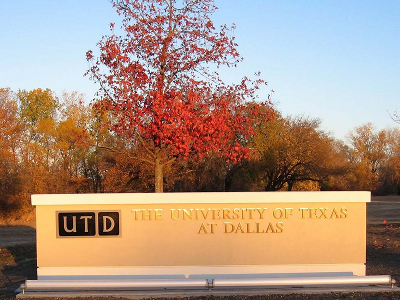
By Rita Cook
When UT Dallas was recently named as one of the greenest universities in The Princeton Review’s Guide to 322 Green Colleges: 2012 Edition folks at that campus weren’t surprised. They have been working to keep it green there with a number of projects for some time. In addition to the most recognizable new Student Services Building, which incorporates a plethora of green-friendly construction features and was awarded the highest certification by the United States Green Building Council (LEED Platinum status) there are and will continue to be more ambitious projects at the school as well.
“Greening our campus has taken off with ambitious projects such as our LEED Platinum Students Services Building,” says Thea Junt, UT Dallas’ Sustainability Manager. “Other efforts are visible in newly constructed buildings, and less visible, but just as important, in our ongoing maintenance and remodel projects.”
Junt says the University’s Facilities Management group has long been a proponent of energy efficiency and resource conservation. Taking this approach to maintenance and construction leads to cost savings, an important part of the business operation, Junt adds.
The newest structure, the Student Services Building was built to take in natural light that helps to reduce energy usage, which Junt explains in more detail stands out because of the use of innovative features like extensive day lighting and a light scoop, solar thermal hot water heating and greywater use in low flow water fixtures. 
“The building was designed to be a one stop shop for our students to house everything from Financial Aid to the Wellness Clinic,” Junt explains. “The exterior has a passive “louver” system, which absorbs solar energy to minimize the heat gain (The UTD Student Services Building) inside the building. Students appreciate the convenience of the campus services being in one place and they love the building.”
Other examples of UTD’s onward eco-friendly march include increased student sustainability efforts with improvements to the Community Garden, Earth Week programming, Recyclemania participation and alternative transportation options such as Zipcar and expanded bus service.
“Students expect their school of choice to be responsible for the environment, so we are,” Junt says. “I also think that we must protect the resources of North Texas be it water, energy or green space. Why does this make for a better campus? Well, I want to work in a place that I’m proud of and I am so proud of the University, both from an academic standpoint to our fabulous students to our amazing buildings and our excellent sustainability programs.”
UTD also recently had a tree planting at the school too, which was a collaboration with several campus departments. Junt says working in Facilities Management and hearing that the Office of Development and Alumni Relations received a “gift of trees,” which needed to be planted it only made sense to get the student’s involved.
“I partnered with the Office of Student Volunteerism to reach out to student groups, and worked with Turner Construction, the donor, to coordinate an event that met all of my requirements. It worked out beautifully. I heard from one graduating senior that she was so happy to have planted a tree on campus, something she can come back and see how it has grown,” Junt explains.
The Turner Tree Planting included 20 Caddo maples trees that were planted near the University’s new Visitor Center, and while a small number compared to the 5,000 planted last year as part of the Landscape Enhancement Project, Junt explains “This impact will be shown time and again when students and their families come back and say “I planted that tree” or a student stops to sit in the shade.”
As for the future of UTD’s green movement folks there are working on more energy conservation projects that, while might not be visible, will still be green such as VFDs on air handling units that will allow the campus to save energy in a number of buildings. The students have also recently passed a Green Fund initiative that will ultimately be up to the President and the Board to implement, but if passed the fund will be a student fee that allows the students to do Green Projects on campus.
Overall, in regard to making green choices on the UTD campus, Junt says the hardest part is choosing which things to do first
“All of the ideas and concepts are important, but creating a methodical process and calculating the appropriate metrics for those ideas has been difficult,” Junt concludes. “Some processes may be perceived as moving slowly or not at all, but we are putting the pieces together to justify some of those projects. Just like any business development, you have to be able to measure the outcomes.”
The Princeton Review’s additional Texas schools for 2012 also include Southern Methodist University, University of North Texas, Austin College, Texas A&M University--College Station and University of Houston.
The rating in order to name these schools is a scale from 60-99 and provides a comprehensive measure of a school's performance as an environmentally aware and prepared institution. Specifically, it includes whether students have a campus quality of life that is both healthy and sustainable, how well a school is preparing students for employment in the clean energy economy of the 21st century as well as for citizenship in a world now defined by environmental concerns and opportunities and how environmentally responsible a school's policies are.
Rita Cook is a freelance writer who has worked as a special Contributor to The Dallas Morning News and other major publications.









